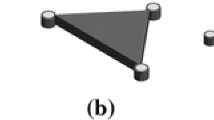Abstract
This paper examines the application of hierarchical discrete spatial representations to the kinematic analysis and synthesis of the higher pairs. Two instances of hierarchical representation are investigated, a global decomposition in the form of quadtrees, and an object-centered, multi-level molecular decomposition. Kinematic reasoning with both representations relies upon the rapid evaluation of the single occupancy constraint. For both representations we present algorithms that allow the rapid detection of intersection between two objects, the analysis of higher pair mechanisms, and a restricted class of kinematic synthesis.
Similar content being viewed by others
References
A. Chakrabarti & T. Bligh. (1994). An approach to functional synthesis of solution in mechanical conceptual design: part I: introduction and knowledge representation,” Research in Engineering Design 6: 127–141.
B. Faltings. (1992). A symbolic approach to qualitative kinematics. Artificial Intelligence 56: 139–170.
B.V. Funt. (1980). Problem-solving with diagrammatic representations. Artificial Intelligence 13: 201–230.
F. Gardin & B. Meltzer. (1989). Analogical representations of naive physics. Artificial Intelligence 38: 139–159.
R. Gupta & M. Jakiela. (1994). Simulation and shape synthesis of kinematic pairs via small-scale interference detection. Research in Engineering Design 6: 103–123.
J. Hahn. (1988). Realistic animation of rigid bodies. (1988). Computer Graphics 22: 299–308.
L. Joskowicz & E. Sacks. (1991). Computational kinematics. Artificial Intelligence 51: 381–416.
L. Joskowicz & E. Sacks. (1994). Configuration space computation for mechanism design. In Proceedings of IEEE Conference on Robotics and Automation.
T. Lozano-Perez. (1983). Spatial planning: a configuration space approach. IEEE Transactions on Computers C-32: 89–120.
N. Hari Narayanan. (1992). Imagery, diagrams and reasoning. Ph.D. thesis, Ohio State University.
P. Olivier, A. Ormsby & K. Nakata. (1995). Occupancy array-based kinematic reasoning. Ninth International Workshop on Qualitative Reasoning, pages 148–155.
F. Reuleaux. (1876). The Kinematics of Machinery. London: Macmillan.
H. Samet. (1990). The Design and Analysis of Spatial Data Structures. Reading, MA: Addison Wesley.
D. Schwartz & M. Hegarty. (1996). Coordinating multiple mental representations for reasoning about mechanical devices. AAAI Spring Symposium on Cognitive and Computational Models of Spatial Representation, pages 101–109.
S. Tessler, Y. Iwasaki & K. Law. (1995). Qualitative structural analysis using diagrammatic reasoning. In J. Glasgow, B. Chandresekaran & N. H. Narayanan, eds., Diagrammatic Reasoning: Cognitive and Computational Perspectives, pages 711–730, AAAI Press.
Author information
Authors and Affiliations
Rights and permissions
About this article
Cite this article
Olivier, P. Kinematic Reasoning with Spatial Decompositions. Constraints 3, 227–237 (1998). https://doi.org/10.1023/A:1009781812127
Issue Date:
DOI: https://doi.org/10.1023/A:1009781812127




